| dc.contributor.author | Баканова, Юлия Александровна | |
| dc.coverage.spatial | Брест | ru_RU |
| dc.date.accessioned | 2025-06-20T10:54:26Z | |
| dc.date.available | 2025-06-20T10:54:26Z | |
| dc.date.issued | 2025 | |
| dc.identifier.citation | Баканова, Ю. А. Методика прогнозирования потребности в кадрах для строительства: основы формирования / Ю. А. Баканова. – Текст : непосредственный // Вестник Брестского государственного технического университета. – 2025. – № 1 (136). – С. 177–182. – Библиография: 20 назв. | ru_RU |
| dc.identifier.uri | https://rep.bstu.by/handle/data/48784 | |
| dc.description | Bakanova, Yu. A. Methodology for forecasting the need for personnel for construction: the basics of formation | ru_RU |
| dc.description.abstract | В данной статье рассматриваются разнообразные подходы и практики применения методов прогнозирования потребности экономики в квалифицированных кадрах. Актуальность данной темы обусловлена необходимостью постоянного обновления и адаптации кадрового состава в условиях динамично развивающегося рынка труда и изменяющихся технологических процессов. В современном мире важность высококвалифицированных специалистов, обладающих уникальными знаниями и навыками, становится все более очевидной. Современные технологии требуют от специалистов специализированных знаний, что увеличивает спрос на подготовленных кадров. Таким образом, процесс прогнозирования потребностей в кадрах становится важным механизмом для сокращения дисбаланса на рынке труда. Проведен сравнительный анализ различных подходов к прогнозированию потребности в кадрах, что позволяет выявить сильные и слабые стороны каждой из методик. В результате анализа сделан вывод о преимуществах комбинированного метода прогнозирования, который интегрирует качественные и количественные аспекты. Этот метод существенно расширяет возможности анализа инвестиционных проектов, планируемых к реализации, а также позволяет более точно оценивать характеристики работников, необходимых строительному комплексу Республики Беларусь. Предложен алгоритм прогнозирования потребности в кадрах для строительной отрасли с использованием указанного комбинированного подхода. Алгоритм учитывает как текущие тенденции на рынке труда, так и прогнозируемые изменения в экономике. Это делает его максимально адаптированным к запросам строительного комплекса. Предложенный подход может служить основой для разработки эффективных стратегий управления кадрами, что в свою очередь будет способствовать повышению конкурентоспособности и устойчивости строительного сектора в стране. Подобные методологии имеют большое значение не только для Беларуси, но и для других стран с аналогичными экономическими условиями. | ru_RU |
| dc.language.iso | ru | ru_RU |
| dc.publisher | БрГТУ | ru_RU |
| dc.subject | методы прогнозирования | ru_RU |
| dc.subject | потребность в кадрах | ru_RU |
| dc.subject | forecasting methods | ru_RU |
| dc.subject | the need for personnel | ru_RU |
| dc.title | Методика прогнозирования потребности в кадрах для строительства: основы формирования | ru_RU |
| dc.type | Статья (Article) | ru_RU |
| dc.identifier.udc | 331.5.024.52 | ru_RU |
| dc.abstract.alternative | This article discusses a variety of approaches and practices for the application of methods for forecasting the need of the economy for qualified personnel. The relevance of this topic is due to the need for constant updating and adaptation of personnel in a dynamically developing labor market and changing technological processes. In the modern world, the importance of highly qualified specialists with unique knowledge and skills is becoming more and more obvious. Modern technologiesrequire specialized knowledge from specialists, which increases the demand for trained personnel. Thus, the process of forecasting human resources needs becomes an important mechanism for reducing the imbalance in the labor market.A comparative analysis of various approaches to forecasting the need for personnel has been carried out, which allows us to identify the strengths and weaknesses of each of the methods. As a result of the analysis, the conclusion is made about the advantages of the combined forecasting method, which integrates qualitative and quantitative aspects. This method significantly expands the possibilities of analyzing investment projects planned for implementation, and also allows for a more accurate assessment of the characteristics ofworkers needed by the construction complex of the Republic of Belarus.An algorithm for predicting the need for personnel for the construction industry using this combined approach is proposed. The algorithm takes into account both current trends in the labor market and projected changes in the economy. This makes it maximally adapted to the needs of the construction complex. The proposed approach can serve as a basis for the development of effective HR management strategies, which in turn will contribute to improving the competitiveness and sustainability of the construction sector in the country. Such methodologies are of great importance not only for Belarus, but also for other countries with similar economic conditions. | ru_RU |
| dc.identifier.doi | https://doi.org/10.36773/1818-1112-2025-136-1-177-182 | |
